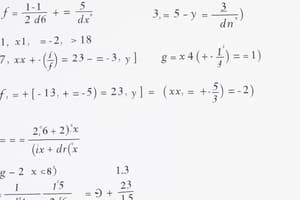Podcast
Questions and Answers
What is a relation?
What is a relation?
A set of ordered pairs.
What is the domain of a relation?
What is the domain of a relation?
All of the x-coordinates of a relation.
What is the range of a relation?
What is the range of a relation?
All of the y-coordinates of a relation.
What is a function?
What is a function?
What does FOIL stand for?
What does FOIL stand for?
What is the distributive property?
What is the distributive property?
What are similar figures?
What are similar figures?
What are congruent figures?
What are congruent figures?
What are variables?
What are variables?
What is an algebraic expression?
What is an algebraic expression?
What is the order of operations?
What is the order of operations?
What are rational numbers?
What are rational numbers?
What are irrational numbers?
What are irrational numbers?
What are perfect squares?
What are perfect squares?
What are integers?
What are integers?
What are whole numbers?
What are whole numbers?
What are natural numbers?
What are natural numbers?
What is the commutative property of addition?
What is the commutative property of addition?
What is the commutative property of multiplication?
What is the commutative property of multiplication?
What is the associative property of addition?
What is the associative property of addition?
What is the associative property of multiplication?
What is the associative property of multiplication?
What is the identity property of addition?
What is the identity property of addition?
What is the identity property of multiplication?
What is the identity property of multiplication?
What is the additive inverse?
What is the additive inverse?
What is the multiplicative inverse?
What is the multiplicative inverse?
What is an equation?
What is an equation?
What is the addition property of equality?
What is the addition property of equality?
What is the multiplication property of equality?
What is the multiplication property of equality?
What is absolute value?
What is absolute value?
What is a linear equation?
What is a linear equation?
What is the standard form of a linear equation?
What is the standard form of a linear equation?
What is an x-intercept?
What is an x-intercept?
What is a y-intercept?
What is a y-intercept?
What is slope?
What is slope?
What is the equation for slope?
What is the equation for slope?
What is slope-intercept form?
What is slope-intercept form?
What does m represent in slope-intercept form?
What does m represent in slope-intercept form?
What does b represent in slope-intercept form?
What does b represent in slope-intercept form?
What is point-slope form of a line?
What is point-slope form of a line?
What is a positive slope?
What is a positive slope?
What is a negative slope?
What is a negative slope?
What is zero slope?
What is zero slope?
What is undefined slope?
What is undefined slope?
What is a constant function?
What is a constant function?
What is an identity function?
What is an identity function?
What is an absolute value function?
What is an absolute value function?
What is a quadratic function?
What is a quadratic function?
What is a system of linear equations?
What is a system of linear equations?
What is a matrix?
What is a matrix?
What is a quadratic equation?
What is a quadratic equation?
What is a parabola?
What is a parabola?
What is the axis of symmetry?
What is the axis of symmetry?
What is the vertex of a parabola?
What is the vertex of a parabola?
Flashcards are hidden until you start studying
Study Notes
Key Definitions in Algebra
- Relation: A collection of ordered pairs that defines a relationship between elements.
- Domain: Represents all possible x-coordinates from a relation.
- Range: Encompasses all possible y-coordinates from a relation.
- Function: A special type of relation where each domain element maps to exactly one range element.
Algebraic Properties
- FOIL: A method used to find the product of two binomials.
- Distributive Property: States that a(b + c) equals ab + ac, demonstrating distribution across addition.
- Commutative Property:
- Addition: The sum remains unchanged irrespective of the order of addends.
- Multiplication: The product remains unchanged irrespective of the order of factors.
- Associative Property:
- Addition: Grouping of addends does not affect the sum.
- Multiplication: Grouping of factors does not affect the product.
- Identity Properties:
- Addition: Adding zero to any number leaves it unchanged.
- Multiplication: Multiplying any number by one leaves it unchanged.
- Inverses:
- Additive Inverse: The sum of a number and its negative equals zero.
- Multiplicative Inverse: The product of a number and its reciprocal equals one.
Numbers and Sets
- Rational Numbers: Can be expressed as a fraction a/b where both a and b are integers.
- Irrational Numbers: Numbers whose decimal representation is non-terminating and non-repeating.
- Perfect Squares: Square roots that result in rational numbers.
- Integers: The set of whole numbers including negatives, zero, and positives.
- Whole Numbers: Non-negative integers starting from zero.
- Natural Numbers: Positive integers starting from one.
Algebraic Expressions and Equations
- Algebraic Expression: Combines numbers, variables, and operations, containing at least one variable.
- Linear Equation: Expresses a straight line graphically; typically takes the form Ax + By = C.
- Standard Form: Refers to the form Ax + By = C for linear equations.
Graphing Concepts
- X-Intercept: The point where the graph intersects the x-axis.
- Y-Intercept: The point where the graph intersects the y-axis.
- Slope: Indicates the steepness of a line, calculated as the ratio of vertical change to horizontal change, expressed by m=(y2-y1)/(x2-x1).
Types of Functions
- Constant Function: A function where output remains constant f(x)=c.
- Identity Function: Defined as y=x, reflecting that every input produces the same output.
- Absolute Value Function: Expressed as f(x)=|x|, which returns the distance from zero.
- Quadratic Function: Formulated as y=ax^2 + bx + c, resulting in a parabola on a graph.
Geometry and Data Analysis
- Parabola: The U-shaped graph produced by a quadratic equation.
- Axis of Symmetry: A vertical line through the vertex of the parabola, dividing it into two symmetrical halves.
- Vertex: The highest or lowest point on a parabola, located at the axis of symmetry.
Systems and Matrices
- System of Linear Equations: Consists of two or more linear equations involving the same variables.
- Matrix: A rectangular arrangement of numbers or variables presented in rows and columns, typically enclosed by brackets.
Graphing Relationships
- Positive Slope: Indicates an upward trend in a graph.
- Negative Slope: Indicates a downward trend in a graph.
- Zero Slope: Represents a horizontal line, indicating no change.
- Undefined Slope: Generally occurs with vertical lines where a change in x does not exist.
These notes consolidate essential algebra concepts and serve as a quick reference for study and revision.
Studying That Suits You
Use AI to generate personalized quizzes and flashcards to suit your learning preferences.




